Chords are 3 notes played at the same time. There are all types of chords. The most common chord is the major chord. Minor chords and Dominant 7th chords are used quite often as well. Some of them may have strange-sounding names at first but don’t let the name scare you.
Chord diagrams show you how to play new chords. This lesson (with video) will show you how how to read a chord diagram.
Below is a blank chord diagram. Think of it as a picture of your guitar sitting in front of you.
The 6 vertical lines represent the 6 strings on a guitar (low E on the left side, high E on right). The horizontal lines represent frets except for the top line which is the nut of the guitar.
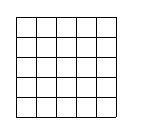
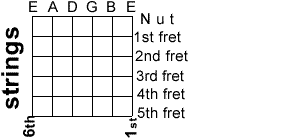
![]()
Black dots on the diagram tell you what fret and string to place your fingers. Numbers inside the dots tell you which finger to use.
![]() White dots mean to play the string open.
White dots mean to play the string open.
Here’s how the fingerings are mapped out on your hand:

![]() =second
=second
finger
Try it!
To play the chord on this chart, place your 2nd finger on the 2nd fret of the 5th string and strum all six strings.

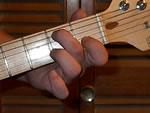
You just played an E minor 7th chord!
Important:
If you see an “X” on a chord chart that simply means that you do not strum that string, otherwise all strings are played. In the example chord below you’ll see an “X” over the 6th string. This means that the string is not used in the chord, so you will not strum it when playing the chord.
A Major
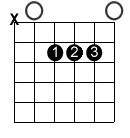
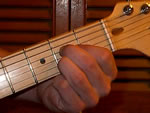
To play this chord, you place your 2nd finger on the D string (4th) at the second fret, your 3rd finger on the B string (2nd string) at the second fret, and your 1st finger on the G (3rd) string the second fret. The A string (5th) and High E string (1st) will be played open (“open” means that the string is not fretted, but strummed in the chord pattern).
Playing Chords
When you’re first learning to play chords, it can be very difficult to get your fingers to cooperate. After a few days of practice, your fingers will start remembering where to go. It’s important to spend a little time everyday with problem chords until you are comfortable with playing them.
Your fingertips on your fret hand will become sore and tender to the touch. If it becomes too painful, by all means, stop practicing for the day and try again the next day. With steady practice, you will develop callouses on your fingertips and this won’t be any more problem.
If you’re hearing a buzzing sound or the sound of the notes being played sounds dull, then your not pressing hard enough on the strings, or one or more of your fingers is catching a nearby string. When you strum the chord each not should ring out clearly. You may find it hard at first to press all of the strings down firmly against the frets. Don’t worry, your hands will build up strength in no time with practice.
Some Random Tips:
- Don’t let your fingernails get too long! They will prevent you from fingering the fretboard correctly.
- Make sure your fingers are standing straight up and down. Otherwise, they may mute other strings.
- When playing chords your fingers should be arched at the joints so that your fingertips come in contact with the strings and not the flat fingerprint part of your finger.
- Your fingers should make contact with the strings slightly behind the frets if at all possible. The further your finger is from the fret the harder it is to apply the proper amount of pressure, hence the more likelihood that you’ll get a “buzzing” sound.
- The size of your hand and the width of your instrument’s neck can significantly affect which fingers you use to play the chords. All of the chord charts on this site use the most commonly used chord fingerings. These fingerings will work for 95% of all guitarists.
- You may come across a suggested chord fingering that you simply cannot contort your fingers to play. In this case, try experimenting with alternate fingerings.